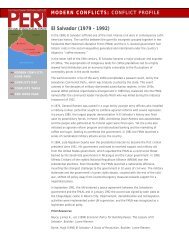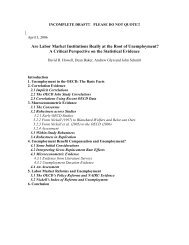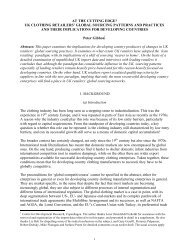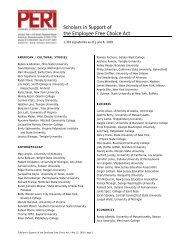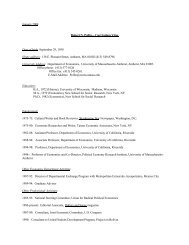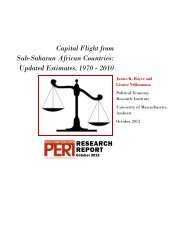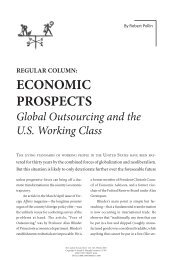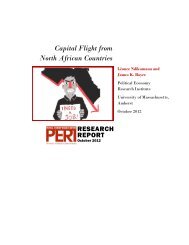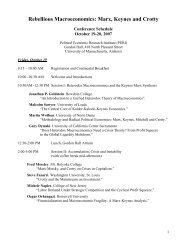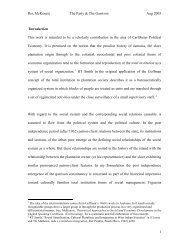The FacTs - Political Economy Research Institute
The FacTs - Political Economy Research Institute
The FacTs - Political Economy Research Institute
You also want an ePaper? Increase the reach of your titles
YUMPU automatically turns print PDFs into web optimized ePapers that Google loves.
<strong>The</strong> Facts<br />
Union Representation and the NLRA<br />
<strong>The</strong> National Labor relations Act (NLRA) was enacted to protect the<br />
rights of workers to join together to form unions to bargain with their employers for<br />
better wages and benefits.<br />
It is the policy of the United States to…“encourag[e] the practice<br />
and procedure of collective bargaining” and “protect the exercise<br />
by workers of full freedom of association, self-organization,<br />
and designation of representatives of their own choosing, for<br />
the purpose of negotiating the terms and conditions of their<br />
employment or other mutual aid or protection. Labor Management<br />
Relations Act, 29 U.S.C. §151<br />
But over the years, the law has been perverted. <strong>The</strong> National Labor Relations Board<br />
(NLRB) representation process has become a virtually insurmountable series of<br />
practical, procedural and legal obstacles. Instead of a protective shield, the NLRA now<br />
acts as a sword that is used by corporations to frustrate employee freedom of choice<br />
and deny workers their right to collective bargaining. <strong>The</strong> proposed Employee Free<br />
Choice Act aims to restore the promise of the NLRA by removing obstacles workers<br />
face when they want to bargain with their employers for a better life.<br />
A recent white paper by the U.S. Chamber of Commerce attacks this reform effort<br />
and defends the failed status quo. Despite the title of its paper, the Chamber ignores<br />
the reality of what workers face when they want to form a union. <strong>The</strong>re is a world of<br />
difference between the rights guaranteed in the NLRA, which the Chamber describes,<br />
and the reality of what happens to workers when they want to achieve collective<br />
bargaining, which the Chamber disregards. It also ignores the explosion of<br />
discrimination cases filed with the NLRB over the past several decades. Significantly,<br />
the Chamber does not cite even one study or academic report in support of its claims.<br />
Remarkably, the Chamber refuses to even acknowledge the policies enshrined in the<br />
NLRA. Despite quoting almost the entire preamble of the act, it shockingly omits the<br />
very language by which the act establishes the labor relations policy of our nation.<br />
Union Representation And the NLRA 1
As much as the Chamber would like our nation’s policy to be neutrality, the twin<br />
goals set forth above—to protect worker organizing and encourage collective<br />
bargaining—remain our official and principal labor relations policies.<br />
<strong>The</strong> NLRA’s path to union representation and collective bargaining no longer works<br />
for workers. One of the most respected human rights organizations in the world,<br />
Human Rights Watch, studied the NLRA process in the United States and concluded<br />
that it is hopelessly broken:<br />
In a system replete with all the appearance of legality and due process, workers’<br />
exercise of rights to organize, to bargain, and to strike in the United States has<br />
been frustrated by many employers who realize they have little to fear from labor<br />
law enforcement through a ponderous, delay-ridden legal system with meager<br />
remedial powers. 1<br />
<strong>The</strong> numbers paint a stark and compelling picture. A study by the Center for<br />
Economic and Policy <strong>Research</strong> (CEPR) found that one in five active union supporters<br />
is fired during workers’ campaigns for collective bargaining—just because they want<br />
a union to bargain for a better life. 2 When a worker who has supported the union<br />
is fired, fear is instantly and inevitably injected into the workplace. Other workers<br />
are afraid the same thing will happen to them if they support the union. This fear<br />
devastates the organizing campaign. And the fear persists because fired workers are<br />
rarely returned to their jobs as lengthy legal delays are common.<br />
<strong>The</strong> NLRB’s representation process foments divisiveness, coercion and fear. During<br />
organizing campaigns, more than half of companies threaten a full or partial<br />
shutdown of the workplace and job loss if the union effort succeeds; almost all<br />
companies force workers into mandatory propaganda meetings; and between 15<br />
and 40 percent make illegal changes to wages, benefits and working conditions, give<br />
bribes to those who oppose the union or use electronic surveillance to spy on union<br />
supporters. 3 This adds up to an inherently and intensely coercive environment.<br />
Before the NLRB agent ever arrives with the voting booth, workers have been<br />
harassed, intimidated, spied on, threatened and fired. <strong>The</strong> NLRB’s portable voting<br />
booth cannot take away the impact of this prolonged climate of fear.<br />
Another major failure of the NLRA is a remedial scheme that is poorly equipped<br />
to deter unlawful conduct of this scale and scope. According to NLRB statistics, in<br />
1969, the number of workers who suffered illegal retaliation for exercising their<br />
federal labor law rights was just over 6,000. By the 1990s, more than 20,000 workers<br />
each year were victims of discrimination. In 2007, according to the NLRB’s Annual<br />
Report, 29,559 workers received back pay because of illegal employer discrimination. 4<br />
Human Rights Watch has concluded that “many employers have come to view<br />
2 Union Representation And the NLRA
emedies [under the NLRA]…as a routine cost of doing business, well worth it to get<br />
rid of organizing leaders and derail workers’ organizing efforts.” 5 This pessimistic<br />
view has been echoed by Prof. Cynthia Estlund, who observed that the act is “widely<br />
flouted by employers who perceive” the discharge of union adherents as an “easy<br />
and cheap response” to an organizing campaign. 6<br />
An employer that has engaged in misconduct during a union organizing campaign,<br />
such as threatening and spying on workers, is merely required to post an NLRB<br />
Notice to Employees promising not to do it again. Workers who are illegally discharged<br />
are entitled to reinstatement and back pay, but no other form of damages. Most<br />
fired employees never return to their jobs and none receives compensation for the<br />
economic and psychological devastation they and their families have had to endure. 7<br />
A company that refuses to bargain is simply ordered to bargain some more. And<br />
delays make these remedies wholly ineffectual, as the remedy typically comes so long<br />
after the workers initiated their organizing efforts that irreversible damage has been<br />
done to their rights.<br />
Contrary to the Chamber’s assertions, the NLRB election process bears no<br />
resemblance to political elections. It is company-controlled and, by every measure,<br />
undemocratic. University of Oregon political scientist Gordon Lafer evaluated the<br />
current union representation process involving secret ballots against American<br />
democratic election standards used to elect public officials. He found the NLRB’s<br />
election process falls alarmingly short of the democratic standards relied on for<br />
our public elections and concluded that the presence of the secret ballot could<br />
not overcome the undemocratic nature of the current process. 8 In a second study,<br />
Lafer examined how the law is applied in the context of organizing campaigns and<br />
concluded that the NLRA also fails to safeguard the privacy of the ballot because<br />
it allows employees to be forced to reveal their preferences to their employer long<br />
before they step into the NLRB’s voting booth. 9<br />
Such a system would not be tolerated if used for public elections. If political<br />
elections were run like NLRB elections, only the incumbent office holder, and not<br />
the challenger, would have access to a list of voters and their home addresses. <strong>The</strong><br />
challenger would not get these until just before the election. Only the incumbent,<br />
not the challenger, would be able to talk to voters, in person, every single day, all day<br />
long. In fact, the incumbent, but never the challenger, could legally require voters to<br />
listen to his or her message under threat of losing their jobs. <strong>The</strong> incumbent could<br />
pull voters off their jobs and make them attend one-sided electioneering meetings<br />
whenever he or she wanted and for however long. Many voters never would talk<br />
to or get information from the challenger—ever—and the challenger could never,<br />
ever make voters come to a meeting, anywhere or anyplace. In fact, the challenger<br />
would have to remain outside the boundaries of the state or district involved and try<br />
Union Representation And the NLRA 3
to meet voters by flagging them down as they drove past. <strong>The</strong> election itself would<br />
always be conducted in the incumbent candidate’s party offices. And even if the<br />
challenger won, the incumbent would remain in office for years while manipulating<br />
the legal process to delay the voters’ choice, frustrate their efforts and discourage<br />
them until they gave up.<br />
This is exactly how the NLRB election process is conducted, with a concentrated<br />
collection of powerful, one-sided privileges favoring the company. And there is<br />
one other compelling difference. In a political election, voters are provided, but<br />
never required to accept, information to make an informed decision. In an NLRB<br />
representation process, where voters are required under pain of termination to<br />
listen to one side’s propaganda, they are relentlessly intimidated into believing<br />
that unionization is at best futile and at worst dangerous. 10 This is the system the<br />
Chamber clings to so desperately.<br />
Delay is another powerful weapon used by companies to sabotage the NLRB’s<br />
representation process and deny workers their rights. <strong>The</strong> Chamber is wrong<br />
to claim the relevant measure is the number of days workers have to endure a<br />
virulent, aggressive anti-union campaign before they can select their union. And<br />
it is misleading to cite the union election win rate as proof that the NLRB process<br />
produces a fair and free result. A more meaningful measure is whether workers<br />
achieve a collective bargaining agreement.<br />
As the NLRB general counsel has recognized, protecting employee free choice is not<br />
just a matter of conducting an election; it necessarily includes protecting bargaining<br />
relationships, especially newly created ones. 11 After all, a contract—not an election—<br />
is the ultimate goal of workers when they choose union representation. Yet out of<br />
1,586 initial contract bargaining cases closed during 2004 by the Federal Mediation<br />
and Conciliation Service, 710 (45 percent of the total) were closed without a contract<br />
being reached. 12 Even more telling, a study based on data obtained from the NLRB<br />
and Federal Mediation and Conciliation found that of the cases where a substantial<br />
likelihood of majority support for unionization was demonstrated and an election<br />
petition was filed, only 20 percent actually resulted in a contract between the union<br />
and employer. 13<br />
Recent surveys show that 60 million nonunion workers would like to have a union<br />
for collective bargaining in their workplaces. <strong>The</strong>y recognize that unions are the best<br />
route to the middle class. Collective bargaining gives working people the tools they<br />
need to win fair wages and fair treatment in corporate America.<br />
More and more, unions and workers are turning away from the NLRB’s process<br />
because it does not protect their right to bargain. Many are gaining representation<br />
rights through voluntary recognition by the employer when a majority signs union<br />
4 Union Representation And the NLRA
authorization cards indicating their choice for union representation. Voluntary<br />
recognition has been a lawful method of achieving union representation since the<br />
act was passed and is how most workers form unions today. In the early days of the<br />
NLRA, representation was determined almost exclusively through a demonstration<br />
of majority support that did not involve balloting. Over the years, majority signup<br />
has been uniformly endorsed by the NLRB, the Supreme Court and Congress.<br />
It is protected by law and currently used by public workers in many states. Highly<br />
successful employers such as AT&T and Harley-Davidson have accepted their<br />
workers’ freedom to choose unions as an important element of their corporations’<br />
successful high-road business plans and have honored their workers’ choice for<br />
union representation through voluntary recognition based on a demonstration of<br />
majority support.<br />
In many ways, the majority sign-up process is superior to the current NLRB<br />
representation process. <strong>The</strong> NLRB process determines representation based on a<br />
majority of workers who vote in an election; majority sign-up requires that a<br />
majority of all employees in the workplace designate the union as their representative<br />
before union representation is achieved. Workers must select a union twice under the<br />
NLRB process, once when they sign cards supporting union representation and again<br />
when the NLRB conducts an election. Majority sign-up eliminates the second step by<br />
honoring the workers’ choice when they first authorize the union to represent them.<br />
<strong>The</strong> majority sign-up process avoids the confrontational, divisive behavior that the<br />
current NLRB process encourages. As part of the current NLRB process, anti-union<br />
consultants train supervisors to treat pro-union workers as traitorous troublemakers<br />
whose union support is anti-company and disloyal. 14 In contrast, majority sign-up<br />
campaigns are associated with significantly less coercion by either companies or<br />
unions than under the NLRB representation process. 15<br />
In its parting shot, the Chamber suggests that the Employee Free Choice Act will<br />
lead to union coercion, a claim based on sheer speculation. <strong>The</strong> evidence is to the<br />
contrary. A review of 113 cases cited by the HR Policy Association as involving fraud<br />
and coercion revealed only 42 decisions in the 78 years since the act’s inception<br />
that actually found misconduct in the signing of union authorization forms. That’s<br />
less than one case every two years. Compare that with the 29,559 instances in 2007<br />
alone of illegal firings and other discrimination against workers for exercising their<br />
federally protected labor law rights. That’s a ratio of almost 50,000 to one. Contrary<br />
to the suppositions of the Chamber, there is no evidence that the Employee Free<br />
Choice Act will generate union coercion. And there certainly is no evidence that it<br />
will engender the kind of endemic, proven coercion that companies routinely inflict<br />
on workers in the NLRB representation process.<br />
Union Representation And the NLRA 5
Conclusion<br />
<strong>The</strong> Employee Free Choice Act would reform the NLRA so workers can choose union<br />
representation and collective bargaining without fear and intimidation. When a<br />
majority of workers demonstrates their choice to form a union, their representative<br />
could be certified by the NLRB without the need for the delay-ridden, coercive and<br />
divisive NLRB election process. Federal labor law finally would guarantee workers<br />
their right to bargain for a better life.<br />
Endnotes<br />
1<br />
Estlund, <strong>The</strong> Ossification of American Labor Law, 102 Columbia L. Rev. at 1588 (citing Compa,<br />
UNFAIR ADVANTAGE, at 16).<br />
2<br />
John Schmitt and Ben Zipperer, “Dropping the Ax: Illegal Firings During Union Election Campaigns,”<br />
Center for Economic and Policy <strong>Research</strong>, January 2007.<br />
3<br />
Kate Bronfenbrenner, Uneasy Terrain: <strong>The</strong> Impact of Capital Mobilization on Workers, Wages and Union<br />
Organizing, Cornell University (2000).<br />
4<br />
NLRB Annual Report, FY 2007; available at: http://www.nlrb.gov/nlrb/shared_files/brochures/<br />
Annual%20Reports/Entire2007Annual.pdf<br />
5<br />
Compa, L. A., and Human Rights Watch, 2000, Unfair Advantage: Workers’ Freedom of Association in<br />
the United States Under International Human Rights Standards, New York: Human Rights Watch, p. 10.<br />
6<br />
Cynthia L. Estlund, <strong>The</strong> Ossification of American Labor Law, 102 Columbia L. Rev. at 23, 24 (2002).<br />
7<br />
Brent Garren, When the Solution is the Problem: NLRB Remedies and Organizing Drives, 51 Labor L.J.<br />
76 (2000).<br />
8<br />
Gordon Lafer, Free and Fair? How Labor Law Fails U.S. Democratic Election Standards (2005).<br />
9<br />
Gordon Lafer, Neither Free Nor Fair: <strong>The</strong> Subversion of Democracy Under NLRB Elections (2007).<br />
10<br />
Gordon Lafer, Working USA: <strong>The</strong> Journal of Labor and Society 1089-7011—Volume 11, March 2008,<br />
p. 90.<br />
11<br />
Memorandum GC 06-05, First Contract Bargaining Cases, April 19, 2006; available at: http://www.<br />
nlrb.gov/shared_files/GC%20Memo/2006/GC%2006-05%20First%20Contract%20Bargaining%20<br />
Cases.pdf<br />
12<br />
http://fmcs.gov/assets/files/annual%20reports/FY04_AnnualReport_FINAL113004.doc.<br />
13<br />
John Paul Ferguson, <strong>The</strong> Eyes of the Needles: A Sequential Model of Union Organizing Drives, 1999-2004,<br />
MIT <strong>Institute</strong> for Work and Employment <strong>Research</strong>, March 15, 2008, p 23; Paul Ferguson & Thomas<br />
A. Kochan, Sequential Failures in Workers’ Rights to Organize, MIT <strong>Institute</strong> for Work and Employment<br />
<strong>Research</strong>, March 2007.<br />
14<br />
Gordon Lafer, Neither Free Nor Fair: <strong>The</strong> Subversion of Democracy Under NLRB Elections (2007), p. 18.<br />
15<br />
Adrienne E. Eaton and Jill Kriesky, “No More Stacked Deck: Evaluating the Case Against Card Check,”<br />
Perspectives on Work, Volume 7, No. 1, June 2003.<br />
6 Union Representation And the NLRA



